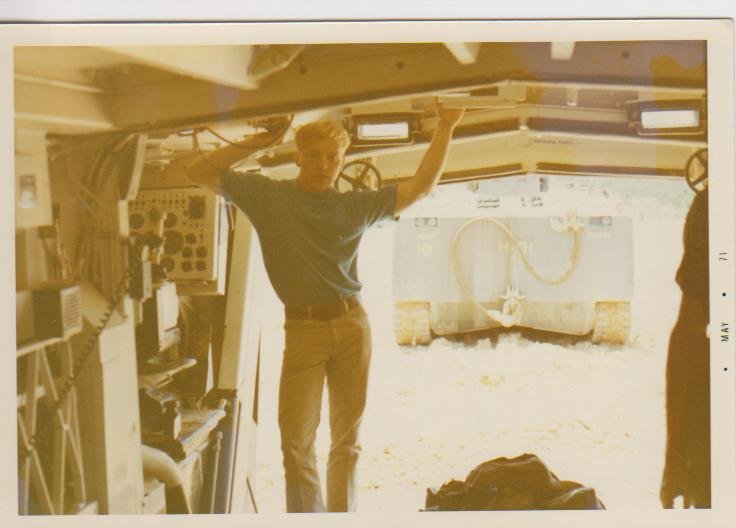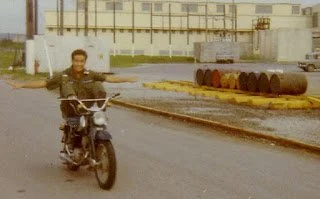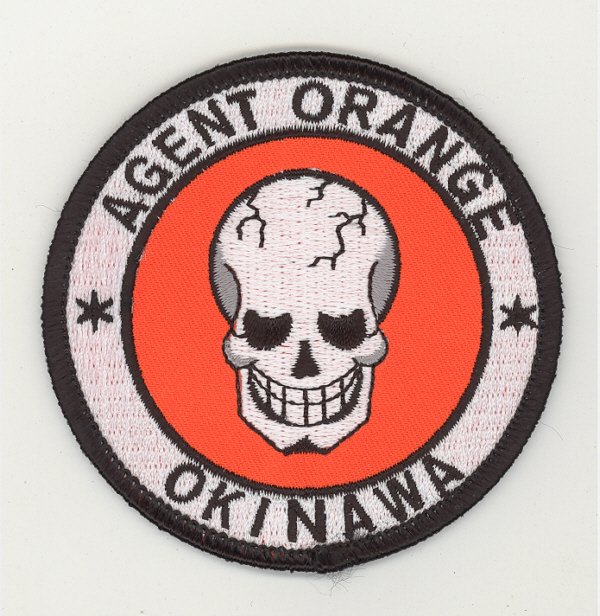UPDATE ON RON FRAZIER: Journalist Jon Mitchell is doing amazing investigative journalism on Agent Orange in Okinawa.
U.S. Marine veteran Scott Parton in front of barrels containing Agent Orange in Okinawa in 1970 or 1971, as reported by Jon Mitchell.
The veteran I am helping, Ron Frazier, is looking for others who might have seen Agent Orange present in Okinawa after 1969.
He has cancer is fighting for benefits.
Luckily, a journalist in Japan is doing great work that hopefully will win the day. If anyone can help, contact me. More about Jon Mitchell's work after the jump.
Ron Frazier in his AmTrac in 1970 or 1971 in Okinawa.
About Ron Frazier: He served in Okinawa in 1970 and 1971. Frazier was put in an AmTrac crew. He was a crew chief. They would train frequently in waters around the island, piloting the amtracs to shore from ships. They would also assist in the transport of supplies to and from Vietnam. These supplies included 55-gallon drums marked black with orange bands -- they held Agent Orange. Frazier would assist in transporting the drums for storage alongside Camp Schwab. Frazier would take his 35mm camera out into the countryside. He remembered following a gully alongside the base, looking to shoot pictures of flowers, and seeing the gallon drums stacked up. He also recalls seeing herbicides used around the rifle range and the dead vegetation that resulted. He would go skin-diving frequently -- you could see all the way to bottom in those waters.
Mr. Jon Mitchell has been breaking news all year on the presence of Agent Orange in Okinawa. His website catalogues a great deal of his reporting. Here’s to hoping that it helps out veterans like Ron Frazier and others who served in Okinawa, but who don’t get the same Agent Orange benefits as those who served in Vietnam.
Veteran Joe Sipala on his motorcycle in front of barrels of Agent Orange in Okinawa.
Veteran Joe Sipala, who is featured in much of Mr. Mitchell’s reporting, has launched his own Website and an awesome patch commemorating the struggle of Okinawa veterans to win their benefits.
Thanks to the work of Mr. Mitchell and the veterans he is reporting on, the evidence of Agent Orange on Okinawa keeps growing. Here is what has been uncovered so far:
1. James Spencer, a U.S. Navy longshoreman on Okinawa’s military docks stated in an
April 12, 2011 article in the Japan Times that in the late 1960s he handled barrels with orange stripes on them that contained Agent Orange, and that the barrels would leak.
2. A medic named Lamar Threet stationed at Camp Kue stated in an April 12, 2011 Japan Times article that Agent Orange was stored a the Kadena Air Force Base, that it was used on Okinawa for vegetation control, and that he personally observed spray crews around hospital grounds, and he was present when a person was brought into the emergency room with his clothes soaked in the herbicide.
3. Joe Sipala, who was stationed at the Awase Communication Site in central Okinawa in 1970, stated in an April 12, 2011 Japan Times article that a truck would come to the site each week and refill a barrel of Agent Orange, which Sipala mixed and sprayed on the weeds around the perimeter fence. A video-taped interview of his testimony is available on YouTube. The article include a photograph of Joe Sipala in Okinawa as a young solider riding his motorcycle past stacks of Agent Orange barrels.
4. In an October 18, 2011 Japan Times article, a U.S. Marine Corp veteran
Scott Parton, who was stationed at Camp Schwab on Okinawa between 1970 and 1971, told the Japan Times that he saw dozens of barrels of Agent Orange on Camp Schwab:
They were stored in a big galvanized barn that was off-limits to most of us. Some of the barrels were marked with a single orange stripe. Others had a double orange stripe.
In the article, Mr. Parton described how American crews would use the herbicides to clear vegetation around Camp Schwab. He stated that officers in the officers’ quarters near a creek where the herbicides were heavily used became sick and were temporarily moved away from the quarters. Mr. Parton stated that when he waded into the creek the skin of feet became affected. Mr. Parton’s statements were accompanied with a photograph of Mr. Parton in 1971 with barrels with orange stripes around middle in the background, which Mr. Parton contends contained Agent Orange.
5. In a November 28, 2011, The Asia-Pacific Journal published an article documenting the current evidence of the presence of Agent Orange in Okinawa. It included the statements of U.S. Marine Corps Lance Corporal Carlos Garay, who was stationed in Okinawa at the Marine Corps Air Station Futenma on Okinawa island between 1974 and 1975. Mr. Garay stated that barrels of defoliants were stored at the Air Station, and that he personally typed up a request to dispose of 12 barrels of the chemicals.
The disposal process was still being decided. Since it was toxic material, only the D.O.D. (Department of Defense) could designate its destination and disposal. I had sent messages to the D.O.D and informed H.Q.M.C. (Headquarters Marine Corps) on several occasions in accordance to follow up procedures, but they never replied.
6. In an August 24, 2011 Japan Times article, Marine Corp. veteran Caethe Goetz stated that she had developed multiple myeloma in 2003. She served at Camp Foster on Okinawa between 1975 and 1976. In the article, she states that it was common to see military personnel spraying herbicides along the perimeter fence of the base.
The fence line was devoid of vegetation. When I walked past it, there was a pungent smell and I would get a headache. One time there was a breeze and some of the mist blew onto me.
7. The same August 24, 2011 Japan Times article also quoted Raymond Adams, a marine who served on Okinawa between 1973 and 1974. Mr. Adams stated:
We routinely sprayed the runway at MCAS Futenma at the wing equipment and support group. It burned my skin. But it kept the grass down and moreover kept the 'habus' (venomous snakes) away.
8. The same August 24, 2011 Japan Times article quoted an unnamed former sergeant who served at Camp Foster between 1972 and 1973, who stated he witnessed Agent Orange used at the camp:
I witnessed on many occasions the Okinawan groundskeepers spraying defoliants around the buildings and refrigeration units at my barracks and others on Camp Foster.
9. In an August 13, 2011 story published by the Japan Times, an unnamed soldier stationed in Okinawa from 1968 to 1970, stated that he witnessed the burial of several dozen drums of Agent Orange in 1969 in Chatan Town on Okinawa. The solider drove a forklift at a U.S. Army supply depot, and he helped load Agent Orange and other supplies onto trucks headed for the Okinawa port of Naha. One of the ships went aground on a reef, and the solider took part in the salvage operation
They brought in men from all over the island to Naha port. We spent two or three days offloading the boat on the rocks. There were a lot of broken containers full of drums of Agent Orange. The 55-gallon (208-liter) barrels had orange stripes around them. Some of them were split open and we all got poured on.
Although the veteran provided his statement anonymously, a photograph of him pointing out the site of the buried Agent Orange accompanies the story. On November 30, 2011, the Japan Times published another story, this time featuring statements from the same anonymous U.S. veteran stated that he witnessed dozens of Agent Orange barrels buried in a central Okinawa town of Chatan near Araha Beach. The veteran stated that the burial took place in 1969 in area that was formerly part of the U.S. Hamby Air Field. The veteran stated that he helped offload dozens of barrels of Agent Orange from an American transport ship that struck a reef in 1969, and that he witnessed the barrels being buried in a 45-meter long trench.
10. A Board of Veterans’ Appeals decision dated January 21, 1998, signed by Board Member Ronald Bosch, number #9800877 determined it was as likely as not the case that a veteran was exposed to Agent Orange between 1961 and 1962 while spraying the herbicide on the sides of Okinawa’s roads and transporting it by truck. In that decision, the veteran testified herbicides were used “particularly near base camp perimeters. Spraying from both truck and back pack were utilized along roadways too.” The unnamed veteran’s full testimony, under oath, was as follows:
I served in Okinawa in 1961-62 at which time we began a massive build-up of supplies and ordnance which included herbicides known as 2, 4, D and 2, 4, 5, T. The combined product of these two chemicals was a 50-50 mix which was then mixed 50-50 with diesel fuel and given the code name “Agent Orange”, for the orange band that was used to mark the drums it was stored in. The purpose of the product was to deny an enemy cover and concealment in dense terrain by defoliating trees and shrubbery where the enemy could hide. In Okinawa we had other uses for it, particularly near base camp perimeters. Spraying from both truck and back pack were utilized along roadways too. The term “Agent Orange” was at the time merely one of several used to identify various herbicides used in the South Pacific. Others included Agents White, Blue, Purple, Pink and Green. Agent Orange was used by far the most. It was my job, MOS-3531 Motor Transport operator (see DD-214 #25 A&B as evidence) to transport troops and cargo. On many occasions the cargo was herbicides known as 2-4-D and 2-4-5T. Sometimes they were full and sometimes they were empty. Sometimes the drums were half full of a 50-50 mix of herbicides and I would have to take them and add the remaining 50% of diesel fuel or kerosene for better dispersion. On many occasions while handling the drums the contents would get on my hands and clothing and when we were spraying along the roadways by truck and back pack the wind would change and blow the herbicides onto our skin and clothing. The thing that bothers me the most is that we were not told or warned about the hazards of the herbicides that we were handling nor were we issued any protective clothing such as gloves and etc. I believe that the frequent exposure to the concentrated unmixed herbicides was much more hazardous than if I would have been sprayed with a diluted thin down mixture.
11. A November 9, 2009 Board of Veterans’ Appeals ruling stated: “The records pertaining to Operation Red Hat show herbicide agents were stored and alter disposed in Okinawa from August 1969 to March 1972.”
12. In a January 5, 2007 Board of Veterans’ Appeals decision, No. 20 667, the Board acknowledged that Operation Red Hat documents indicated that Agent Orange was used and stored on Okinawa between August of 1969 to March of 1972:
In an August 2004 letter to the Ranking Member of the House of Representatives' Committee on Veterans' Affairs, an Air Force official stated that its Historical Research Agency (AFHRA) was unable to find any documentation referring to Agent Orange, herbicide, defoliant, or dioxin in conjunction with Okinawa, although an attachment to the letter listed numerous Operation Red Hat documents that indicated possible storage of herbicides and chemical agents there between August 1969 and March 1972.
13. A September 8, 1966 Air Force document indicates that Agent Orange was used and stored on Okinawa. The report summarizes the findings of a Air Force Staff Visit by entomologist Walter W. Barrett, that was made to the Philippines, Taiwan and Okinawa between August 7, 1966 and August 24, 1966. The Okinawa trip included visits to the Naha Air Base, the Kadena Air Base, and potentially the U.S. Army headquarters and Medical Laboratory. One item on Mr. Barrett’s agenda was to “review base programs and assist individual bases with establishment of safer and more effective programs” including herbicides. Mr. Barrett distributed literature at these bases concerning “some of the newer chemicals now available for pest and weed control plus informing medical departments on toxicity data, safe handling rules and other use data.” The report includes a recommendation that “Mity Mite” back-pack sprayers be used where possible The final page of the report states as follows:
Item #8: (Unclassified)(Philippines, Taiwan and Okinawa)
SUBJECT: Herbicides
DISCUSSION:
Herbicide literature was handed out at the Subic Bay conference and samples were mailed by Mr. E. Raymond Gross, Command Agronomist. (Application of materials is frequently assigned to pest control personnel because they have the sprayers and spraying experience.)
[Restrictions] on herbicide usage apply as they do for other pesticides. If non-stock listed herbicides are used, request for their approval shall be forwarded per AFR 616-1.
Similarly, herbicides used should be “backed-up” by usaged sheets from each manufacturer.
Sprayer listed in Section A T/A 479 (3740-515-5064) should be used for weed killers while the same item listed in Section B, T/A 479 should be reserved for insecticides, to eliminate spray injury frequently caused by using the same sprayer for both materials.
RECOMMENDATIONS:
Clarify placement of function for herbicide spraying.
Secure surgeon’s approval of non-standard herbicides.
Secure data sheets on each product used.
Procure sprayer discussed above for herbicide usage, particularly when wettable powder materials or suspensions are used.




